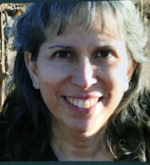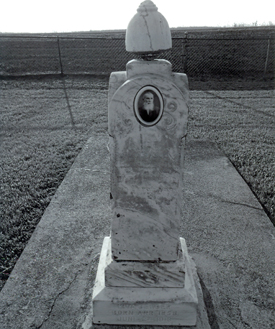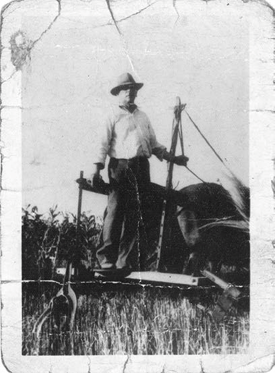By Rebecca Bender

RICHFIELD, Minnesota — It was a brisk day – the kind of early-autumn day when the falling leaves are still appreciated for their unique twirls from the trees to the ground. With my sister Nancy’s help, I carried in the boxes of books I optimistically hoped to sell, following my reading. There I was, a Jew, raised in heavily-Jewish St. Louis Park, the invited speaker at the monthly meeting of the Minnesota chapter of the Germans from Russia, at a Lutheran church in Richfield. To those who didn’t know my family’s history, it may have seemed like an unusual pairing. Far from it. I was right where I was supposed to be.
It all started in 2013, when my son Lincoln was with me, visiting the Ashley, North Dakota Jewish Cemetery where my great-grandfather is buried. He began asking me questions about the community of Russian Jewish immigrants, who arrived in the early 1900s with no farming experience, to farm the North Dakota prairies. I didn’t have sufficient answers. But the seed was planted for me to learn more – for my son, myself, our family, and people I had never met.
After much research in three states, a lot of “you’ll never succeed, you’re not a historian” advice, and one failed attempt, I was ultimately successful in achieving a listing of the remote Ashley Jewish Homesteaders Cemetery on the National Register of Historic Places.
Mission completed … or was it? “What about the people who happen by this cemetery and wonder about the Hebrew writing on the monuments?” I thought. This question led to the second stage of this unplanned quest — fundraising to place half-ton boulders with explanatory plaques on the site, to further preserve this Jewish community’s history. Fortunately, the Jewish American Society for Historic Preservation agreed to match donations we received from descendants of those buried at the Jewish Homesteaders Cemetery and others with no apparent connection. I, and the other two board members of the cemetery association, sent out invitations to a rededication. I naively set the event for mid-May, figuring the weather would be welcoming.


Over 100 people arrived– Jews and non-Jews from seven states — most savvy enough to be wearing hats and coats to combat the cold wind, which promptly blew over my sister’s and my music stands before our violin/flute duet of “Sim Shalom,” (“Spread Peace”). We acknowledged the wind’s power but refused to acknowledge its sovereignty. My nephews held our music, and the wind begrudgingly carried our notes over the tall-grass plains.
After the ceremony, I scheduled a reception at a nearby 99-year-old barn recently converted to a dinner theater, with an American flag painted on its weathered roof. I brought eight pans of buttermilk kugel I carefully prepared using my late mother’s recipe, and the tables were decorated with kosher chocolates and lilacs in old milk-jugs. The whole experience was a bit surreal for a city girl like me. At times, I felt like an actor playing someone else’s part — with the big-sky venues and the wind machine on an enormous Hollywood sound stage.
Thus began phase three, as organically as phases one and two had commenced – a book that seemed to write itself. In the course of my research, I had discovered so many inspiring stories regarding my family, who escaped the Odessa pogroms that killed my grandfather’s two older brothers. And shortly before my dad’s death, he had handwritten stories that I typed into “From the Prairies to the Beaches,” the manuscript about his journey from the Dakotas to the beaches of Normandy on D Day +1. The common themes over five generations — of faith despite challenges, perseverance, trying to lead a good life, and gratitude for America’s freedoms — were too overwhelming to ignore. And there was another unexpected theme that appeared and spoke loudly over 150 years – similarities and repeated acts of kindness back and forth, between groups of people who from outward appearances might not have seemed to have much in common.
When my Russian Jewish ancestors arrived in McIntosh County, North Dakota, from Odessa, Russia, by way of steerage on the Red Star Line out of Antwerp, Belgium, they landed at the base of the German-Russian Triangle (sometimes affectionately called “the Sauerkraut Triangle.”) Over 75% percent of the population in the area was made up of Black Sea German Protestants, mostly Lutheran. They began moving from Germany to Russia to farm in the 1760s, based upon promises of Catherine the Great that they could own land and would be allowed to maintain their culture and language as well as be exempt from Russian military service.
Gradually, these promises that induced them to move were broken. The increase in anti-German sentiment in Russia resulted in a great hegira of the German-Russians to the Dakotas.
Surprisingly, the connections between the Russian Jewish immigrants to the area and the German-Russians were not merely that they became neighbors once arriving in America. The Jews and German-Russians had worked together in Russia, developing a level of trust that continued over 5000 miles away, in Ashley, North Dakota. In Russia, Jews were not allowed to own land to farm, as a result of the 1882 May Laws. The fact that these decrees existed, restricting occupational choices based solely upon one’s faith, resulted in many Jews earning a living working directly with the German-Russians. The German-Russians raised wheat, corn, and rye; the Jewish grain merchants bought the grain at the farms; and the Moldavian peasants hauled the crop by wagons to the train depot.
Also, according to old newspaper accounts, the Germans from Russia (and also the Jews) believed that living in Ashley would be somewhat similar to living in Odessa, as both cities had a 46-degree latitude. It was not. The immigrants didn’t realize that factors such as distance to the nearest ocean and elevation affected climate, and that the depositing of Canadian Shield core bedrock by glaciers moving across the North Dakota land 12,000 years earlier affected the quality of the land for farming. Much of McIntosh County, North Dakota’s homestead land was filled with rocks and stones, and the weather could fluctuate widely, between extreme cold and heat, not to mention tornados, blizzards, prairie fires, and drought. But the great majority of Jews and German-Russians had something else in common — they were willing to put up with tying themselves with a rope to their door, in case a blizzard would come up while they were feeding the animals, so they could find their way back, and filling their sodhouse coal stoves every two hours – in return for the religious freedom and independence that America offered.
I submitted my manuscript entitled Still, covering 150 years and five generations of my family’s stories, to several publishers. Dr. Suzzanne Kelley at North Dakota State University Press shared my excitement over the subject matter, as did the anonymous reviewers of my manuscript and the Editorial Board of NDSU Press. After the book release came the book talks and the signings. Different venues called for different focuses for my readings.
At the Lutheran church in Richfield, over 100 years after the Jews and Germans had been farming neighbors, I began telling some of the stories of community between the groups. I told the story of my great grand-aunt Sarah, who, being fluent in English, Russian, German, and Yiddish, served as a go-between for the American doctor when the non-Jewish German women were ready to give birth. Farmers would come to the door of the Auerbachs’ house and knock at all hours, so Sarah would go with the farmer to get the doctor and stay to translate until the baby was born. A number of German mothers were so thankful; they named their baby daughters Sarah, after my aunt.
And the story of Israel, my great-grand uncle, who owned the Ashley General Store, and would sell staples – flour, sugar, and salt – at cost to farmers down on their luck, and would hold their bills until the crop came in, which eventually led him almost into bankruptcy. The morning Israel appeared at the bank to give them the keys to his store, his non-Jewish neighbors, appreciative of his kindnesses over the years, had lined up to cosign any note the bankers desired, with their farms as collateral, so their friend could stay in business. And my Grandpa Joe Bender, who lent money to a German man to purchase his first farm, on a handshake, asking him only to pay “as he could” and who with my Grandma Mary at Benders Farmers Cash Store in Eureka, South Dakota, had prices that frequently slid down to cost for customers in need of warm coats and boots.
Then it was the question-and-answer portion. A slight lady in the front row, who I later learned is 92-years-old, raised her hand, and was given the microphone. “I just have to tell all of you,” the woman began, “that I have read this book. I have read the translations of the prayers the Jewish people recite. You should buy this book and read it all, even the footnotes. You will see what I discovered – we are all so similar.” I thanked her and told her that one of my goals in writing Still was to show the similarities between people of faith, and that her comments were therefore very meaningful to me.
Next, a gentleman who I knew to be a well-known German translator took the microphone and asked if he could share a story. His family was from Mercer, North Dakota. He told a story of Alle Dakovna, a Jewish former hide buyer who used to have Mercer on his route and in 1915 put down roots and opened a general store there. Alle was known as an empathetic fellow, who would not demand payment immediately if the buyer could not afford the intended purchases. When the speaker’s father was setting up a bulk oil/petroleum operation years later and checked with the speaker’s grandfather for advice about dealing with late-paying farmer customers, the grandfather said, “Treat them like Alle Dakovna would — grant them credit until the crop comes in.”
After this story, the member of the Germans from Russia chapter who had introduced me, took out a map of the villages in the Black Sea region of Russia in the late 1800s, early 1900s. Amazingly, the small town where her German ancestors had lived before emigrating, was about 35 miles away from where my great-great grandparents had their winemaking business, where my great-grandparents met and married, and where my grandfather was born.
I sold more books at that Germans-from-Russia meeting than at any of my other readings to date. One of the attendees even attempted to blow the shofar (ram’s horn) I had brought — used by Jews at the High Holidays as in ancient times, to call upon us to examine our deeds and correct our ways. When I returned home, I emailed my dad’s younger brother David in California, to tell him about the wonderful afternoon. He, as usual, summed it up perfectly, and succinctly. “Sweeter than a double-decker cone,” my uncle said.
*
Rebecca Bender, a securities litigation attorney in Minnesota for 18 years, then a special education teacher’s aide and substitute teacher, is honored that the nonfiction biography/memoir she co-wrote with her dad, Still (NDSU Press 2019), a walk through 150 years of Jewish history on 3 continents, was recently awarded the 2019 Independent Press Award (Judaism category). The book is available through NDSUPress.org, Amazon.com, or may be ordered through any bookstore.
I love the book and the above write-up, but I find the expression, the sauerkraut triangle derogatory. Sorry!
Hi Shirley. Thank you for your kind comment about Still. I also appreciate your taking the time to submit your feelings and apologize for having offended you or anyone else. My use of the term was based upon my having heard this term a number of times expressed by the Germans from Russia who still live in this area of North and South Dakota, always accompanied by a chuckle — referring to the large amount of the traditional food by that name eaten by the German-Russians in the area (along with knoephle and kuchen). This designation is food-based — similar to “The Borscht Belt” (describing the area with lots of Jews that used to have a lot of summer resorts in the Catskills with kosher food, including borscht, followed by vaudeville entertainment – named after the soup brought by Jews when emigrating from Europe to America), and “The Jell-O Belt” (describing where there is a large population of Jesus Christ of Latter-day Saints, who traditionally purchase a lot of Jell-O — when the Olympics were held in Salt Lake City, one of the pins sold was of green Jell-O in the shape of the state of Utah). I have learned from you to be more sensitive in my use of all terms and thank you for educating me. : )
What an amazing Jewish story! Thank you for sharing. I am uncovering so many Jewish stories that are similar in a 100 mile radius of my hometown in South Central Kansas 15 miles from the Oklahoma border. I will try to find your book to share with the folks I am uncovering.
Thank you, Rosalea. As the Great Plains go from Texas up through Canada, it is very possible there are homesteading stories of Jewish farmers in many of these areas. At the time that my ancestors began arriving from Russia (early 1900s – as a result of the pogroms), much of the good homestead land in states with warmer climates and larger population centers had been claimed. The Dakota climate challenges (which kept some potential homesteaders away) and the lack of railroad lines to many areas in North Dakota until the early 1900s, resulted in available, albeit rocky, North Dakota land. My ancestors were thankful for the opportunity to own land for farming in America, a privilege denied them in Russia. Thank you for your interest!